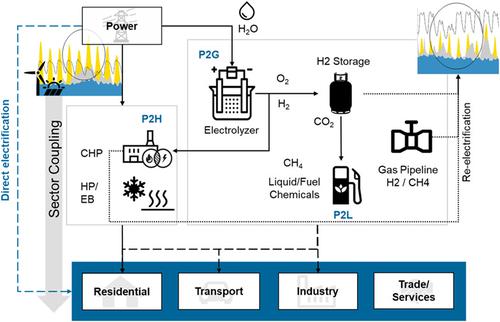当前位置:
X-MOL 学术
›
WIREs Energy Environ.
›
论文详情
Our official English website, www.x-mol.net, welcomes your feedback! (Note: you will need to create a separate account there.)
The sector coupling concept: A critical review
Wiley Interdisciplinary Reviews: Energy and Environment ( IF 6.1 ) Pub Date : 2021-02-04 , DOI: 10.1002/wene.396 Jasmine Ramsebner 1 , Reinhard Haas 1 , Amela Ajanovic 1 , Martin Wietschel 2
Wiley Interdisciplinary Reviews: Energy and Environment ( IF 6.1 ) Pub Date : 2021-02-04 , DOI: 10.1002/wene.396 Jasmine Ramsebner 1 , Reinhard Haas 1 , Amela Ajanovic 1 , Martin Wietschel 2
Affiliation

|
Pursued climate goals require reduced greenhouse gas emissions by substituting fossil fuels with energy from renewable sources in all energy-consuming processes. On a large-scale, this can mainly be achieved through electricity from wind and sun, which are subject to intermittency. To efficiently integrate this variable energy, a coupling of the power sector to the residential, transport, industry, and commercial/trade sector is often promoted, called sector coupling (SC). Nevertheless, our literature review indicates that SC is frequently misinterpreted and its scope varies among available research, from exclusively considering the use of excess renewable electricity to a rather holistic view of integrated energy systems, including excess heat or even biomass sources. The core objective of this article is to provide a thorough understanding of the SC concept through an analysis of its origin and its main purpose, as described in the current literature. We provide a structured categorization of SC, derived from our findings, and critically discuss its remaining challenges as well as its value for renewable energy systems. We find that SC is rooted in the increasing use of variable renewable energy sources, and its main assets are the flexibility it provides for renewable energy systems, decarbonization potential for fossil-fuel-based end-consumption sectors, and consequently, reduced dependency on oil and gas extracting countries. However, the enabling technologies face great challenges in their economic feasibility because of the uncertain future development of competing solutions.
中文翻译:

部门耦合概念:批判性审查
追求气候目标需要通过在所有能源消耗过程中用可再生能源替代化石燃料来减少温室气体排放。在大规模上,这主要可以通过风能和太阳能发电来实现,这些电能具有间歇性。为了有效地整合这种可变能源,通常会促进电力部门与住宅、交通、工业和商业/贸易部门的耦合,称为部门耦合 (SC)。然而,我们的文献综述表明,SC 经常被误解,其范围因现有研究而异,从专门考虑使用过剩的可再生电力到综合能源系统的整体观点,包括过剩的热量甚至生物质源。如当前文献所述,本文的核心目标是通过对其起源和主要目的的分析,提供对 SC 概念的透彻理解。我们根据我们的发现对 SC 进行了结构化分类,并批判性地讨论了其剩余的挑战及其对可再生能源系统的价值。我们发现 SC 植根于越来越多地使用可变可再生能源,其主要资产是它为可再生能源系统提供的灵活性、基于化石燃料的终端消费部门的脱碳潜力,从而减少对石油的依赖和天然气开采国。然而,由于竞争解决方案未来发展的不确定性,使能技术在其经济可行性方面面临巨大挑战。
更新日期:2021-02-04
中文翻译:

部门耦合概念:批判性审查
追求气候目标需要通过在所有能源消耗过程中用可再生能源替代化石燃料来减少温室气体排放。在大规模上,这主要可以通过风能和太阳能发电来实现,这些电能具有间歇性。为了有效地整合这种可变能源,通常会促进电力部门与住宅、交通、工业和商业/贸易部门的耦合,称为部门耦合 (SC)。然而,我们的文献综述表明,SC 经常被误解,其范围因现有研究而异,从专门考虑使用过剩的可再生电力到综合能源系统的整体观点,包括过剩的热量甚至生物质源。如当前文献所述,本文的核心目标是通过对其起源和主要目的的分析,提供对 SC 概念的透彻理解。我们根据我们的发现对 SC 进行了结构化分类,并批判性地讨论了其剩余的挑战及其对可再生能源系统的价值。我们发现 SC 植根于越来越多地使用可变可再生能源,其主要资产是它为可再生能源系统提供的灵活性、基于化石燃料的终端消费部门的脱碳潜力,从而减少对石油的依赖和天然气开采国。然而,由于竞争解决方案未来发展的不确定性,使能技术在其经济可行性方面面临巨大挑战。

























 京公网安备 11010802027423号
京公网安备 11010802027423号